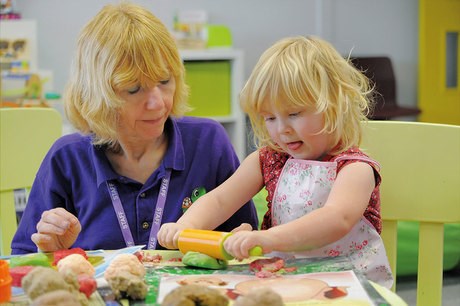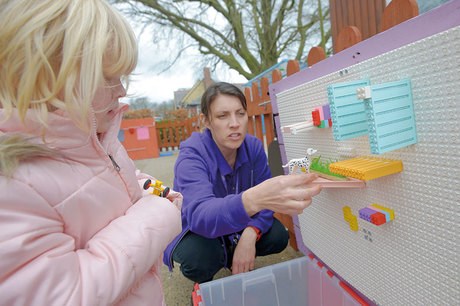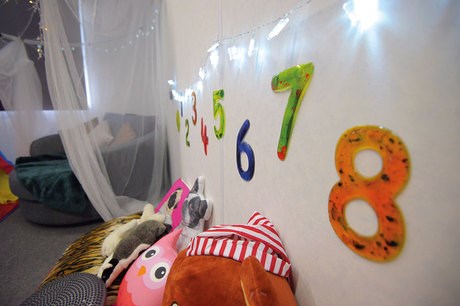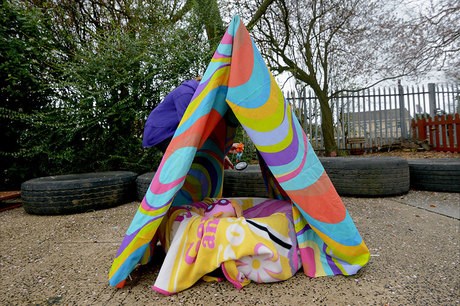Nursery Equipment: Provision - World of discoveries
Charlotte Goddard
Monday, May 15, 2017
In Northumberland, one setting has created an environment for children with special educational needs and disabilities. By Charlotte Goddard

Kath Dickinson and her daughter Sarah are strong believers in giving children with additional needs the best possible start in life. Together they have more than 30 years’ experience working with children with special educational needs and disabilities – Kath as a teacher in a special school, and Sarah as a classroom assistant, among other roles. This background led them to open nursery SEND to Learn in the former mining village of Pegswood, Northumberland, at the beginning of 2017.
SEND to Learn is located in a purpose-built Sure Start children’s centre that was closed in 2016 due to lack of funding. ‘It was an ideal building standing empty, so we worked with the local authority early years team to set up SEND to Learn,’ says Ms Dickinson. ‘We have invested around £10,000.’
SEND to Learn operates as a community-driven social enterprise, so profits go straight back into supporting the setting and the local community. Around a dozen children attend the nursery, which runs on a staff ratio of one to four because of their high needs. It also runs a weekly parent and child group, attended by around 15 children.
While the nursery prioritises those with special educational needs and disabilities, it is open to all children.
LEARNING THROUGH TOUCH
The setting has been able to incorporate some of the children’s centre’s fixtures and fittings, such as child-height toilets and sinks and special wet-room flooring. Other elements have been tweaked to make them appropriate for children with additional needs. A small meeting room, for example, has been transformed into a custom-made sensory area, with equipment including a bubble tube, which was bought from high-street chain B&M. Tactile letters and numbers help children learn through their sense of touch as well as sight.
The team was not allowed to make any structural changes to the building, but they installed blinds in the sensory room and covered the walls with fabric. ‘A lot of children with additional needs can become over-stimulated and the room helps to calm them,’ says Ms Dickinson. A ‘cuddle chair’, a large, living-room-type chair which rotates, and is big enough for a child to snuggle down in, is currently in the sensory room, but can be moved about as required.
A buggy storage area has become an outdoor sensory shelter, with plants such as lavender and rosemary, noise-making equipment like shakers and wooden spoons, and a range of fabrics with different textures. A shed is now an adventurous outdoor reading area. ‘There are torches for reading in the dark, soft toys and blankets inside,’ explains Ms Dickinson. ‘We recently covered the outside with camouflage paint to make it more visually appealing.’
As well as the sensory room, the nursery has two main indoor learning areas.
‘All rooms have been designed with SEN in mind, and to allow free movement,’ says Ms Dickinson. There is a mixture of different types of furniture, such as stools and chairs, of different heights and colours. ‘Some children with autism can be very fixed on a certain type of chair or a certain colour,’ she adds. ‘By offering a range, we can introduce children to making choices.’
In the first room, used for messy and creative activities, children can crawl through a tunnel and bounce on a trampette. Some build in the construction area, while others role-play in the dressing-up space. Many enjoy sitting in the car tyres, which are used as immersive spaces. ‘The tyres are particularly popular with the children, and with parents who attend our weekly parent and child sessions, who see them as a safe space for their children to sit and be supported,’ says Ms Dickinson. ‘We pad the tyres with blankets and pillows, covered with a waterproof fabric.’
In the second room, children take part in table-based activities, or snuggle up in the reading area, which contains bean bags and a wobble cushion. These plastic cushions can be used to encourage ‘active sitting’ as their rounded shape means children must actively use their supporting muscles to remain stable. One side has an anti-slip surface, and the other is designed to stimulate a child’s sensory receptors with tiny bumps. ‘Some children have a tendency to fiddle, and the cushion helps with that,’ explains Ms Dickinson. ‘We also have cushions made of lots of different types of fabric, with buttons on them that children can play with, which we made ourselves.’ The reading area has big soft toys which children can share books with, if they prefer that to being with an adult.
This room also contains a therapy ball and a ball pit. The brightly coloured balls entice children inside, while massaging the entire body, providing buoyant support, and encouraging relaxation. The visual, auditory and tactile sensory stimuli build confidence and strengthen motor skills.
ONGOING EVALUATION
Outside areas have been designed and equipped to allow children to continue to learn as they play. As with the inside areas, some equipment has been bought, but most has been adapted, donated and upcycled.
‘We have learned to be very creative with free resources, such as pallets and tyres,’ says Ms Dickinson. A fairy garden with little doors made by the team has been set up for children to actively explore, and a mud kitchen equipped with pots and pans provides a great learning space, encouraging role play, sharing and turn-taking.
‘One area they are not so good at is sharing, so it is good to learn this way,’ says Ms Dickinson. The popular mud kitchen also helps children develop fine motor skills as they grip utensils and lift bowls, and provides a basis for explorations into measuring and other science, technology, engineering and mathematics (STEM) topics.
Children develop their gross motor skills on the bikes and trikes, as well as on two different swings. The nursery is planning to buy a nest-type swing to add to the collection. They climb up and slide down the raised playhouse: this was already on-site, but the nursery has adapted the equipment. ‘We have painted the underneath of our climbing frame in blackboard paint, so children can lie down and write underneath,’ says Ms Dickinson.
Staff created an outdoor Lego wall by covering wooden pallets with flat Lego plates. ‘You can move them around if you need to, so children in wheelchairs can reach it,’ says Ms Dickinson. Letters and numbers are painted onto tyres, which are also filled with small items, such as pinecones, or model dinosaurs, with children encouraged to move objects from one tyre to another.
‘We continually evaluate the equipment and how it is being used,’ says Ms Dickinson. ‘Sometimes we leave something out for a week or so, because the children don’t interact at first. The nursery is free-flow; some children do all their learning in the more messy room as opposed to the more formal room.’ Although the nursery has only just opened, there are a few pieces of equipment that have been replaced after watching how children interacted with them. ‘With the ball pits we have had a car-shaped one, but now we have a circle one, and they like that better at the moment.’
MULTI-PURPOSE
Practitioners take note of children’s needs and interests and use this knowledge when it comes to equipping the nursery. ‘During their first few sessions we make lots of observations, as well as chatting to the parents,’ says Ms Dickinson. ‘At the end of the first week, we put together a programme to meet their individual needs. If a child has a particular interest, we will look at obtaining equipment that will link to that.’
Ms Dickinson’s years of experience in a special school stood her in good stead when equipping the nursery. ‘I know which suppliers to use, such as Explore Your Senses, Yellow Door and Baker Ross,’ she says. ‘Pinterest is fabulous to look at what’s out there.’
Early Years Pupil Premium funding is used towards paying for equipment which aims to improve the attainment of the funded child, and the setting also collects Active Kids vouchers to help buy equipment.
‘When choosing equipment we think about the cost of it, the durability and, most important, whether it can have more than one purpose,’ says Ms Dickinson. ‘Everything we use has to be suitable for children whether they have special educational needs or not.’
The nursery equipment is designed and deployed so that children can access it themselves, such as child-height soap dispensers and labels on doors, which include pictures. ‘Equipping a nursery like ours should not be different from equipping a mainstream nursery in theory. But in practice, mainstream nurseries are very busy places, they often have too much equipment out, and too much stuff on the walls, so children with special needs can be overwhelmed,’ says Ms Dickinson.
‘We also think about the size of equipment relative to children in wheelchairs, or those who might have mobility issues.’
PARENT’S VIEW
Four-year-old Kiara, who has non-verbal ASD, attends SEND to Learn every day. Her mother, Kim Bell, says the nursery is fantastic, and is the one place Kiara gets excited to go to.
‘The staff are brilliant,’ she says. ‘My daughter is whizzing through her Picture Exchange Communication System (PECS) book and learning Makaton. She doesn’t get frustrated as she is able to communicate.’
Kiara enjoys climbing, and benefits from the setting’s outside climbing frame, says Ms Bell. ‘She also likes the mud kitchen – she loves messy play but doesn’t like to get messy herself, so it’s great that the nursery is equipped with aprons to keep the children clean.’
Kiara uses the sensory room ‘now and then’, says her mother, although she was scared of it at first as it was new to her. ‘She really loves the cuddle chair they have.’
Ms Bell is particularly enthused about how the design of the nursery helps Kiara to communicate and understand. ‘There’s lots of room for every activity. It’s all open, and there are pictures and text on everything so Kiara knows what is in the different drawers, for example, without opening them,’ she says. ‘She has a timetable for all her different activities which also uses pictures, so she knows what is happening and which room it is in.’
SEND TO LEARN RECOMMENDS:
Rompa
Equipment for sensory rooms such as bubble tubes, wall panels and lighting, www.rompa.com
 Explore your senses
Explore your senses
Sensory equipment such as weighted soft toys, www.exploreyoursenses.co.uk
TFH
Equipment for children with special needs such as nest swings, www.specialneedstoys.com
![]() YPO
YPO
Includes outdoor equipment and puzzles, www.ypo.co.uk
 Yellow Door
Yellow Door
Language-rich play equipment such as outdoor learning cards and letter stones, www.yellow-door.net
Rhino Play
Outdoor play equipment and safety surfacing, www.rhinoplay.co.uk
Baker Ross
Arts and crafts resources supplier, www.bakerross.co.uk




